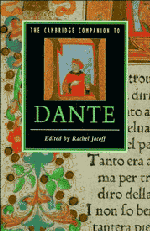Book contents
- Frontmatter
- 1 Life of Dante
- 2 Dante and the lyric past
- 3 Approaching the Vita nuova
- 4 The unfinished author
- 5 Dante and the empire
- 6 Dante and Florence
- 7 Dante and the classical poets
- 8 Dante and the Bible
- 9 The theology of Dante
- 10 A poetics of chaos and harmony
- 11 Introduction to Inferno
- 12 Introduction to Purgatorio
- 13 "Shadowy prefaces"
- 14 Dante and his commentators
- 15 Dante in English
- Further reading
- Index
13 - "Shadowy prefaces"
an introduction to Paradiso
Published online by Cambridge University Press: 28 May 2006
- Frontmatter
- 1 Life of Dante
- 2 Dante and the lyric past
- 3 Approaching the Vita nuova
- 4 The unfinished author
- 5 Dante and the empire
- 6 Dante and Florence
- 7 Dante and the classical poets
- 8 Dante and the Bible
- 9 The theology of Dante
- 10 A poetics of chaos and harmony
- 11 Introduction to Inferno
- 12 Introduction to Purgatorio
- 13 "Shadowy prefaces"
- 14 Dante and his commentators
- 15 Dante in English
- Further reading
- Index
Summary
THE GOD INVENTED and gave us vision in order that we might observe the circuits of intelligence in the heaven and profit by them for the revolutions of our own thought, which are akin to them, though ours be troubled and they are unperturbed; and that, by learning to know them and acquiring the power to compute them rightly according to nature, we might reproduce the perfectly unerring revolutions of the god and reduce to settled order the wandering motions in ourselves.
(Plato, Timaeus 46c)The Paradiso is the continuation and culmination of the earlier canticles, and at the same time a new departure. Refiguring themes, issues, images, and episodes from Inferno and Purgatorio, it nonetheless establishes a new set of conditions for both the poet and the reader. While the poet's memory has hitherto been sufficient to his task, the Paradiso acknowledges the gap between memory and experience in its opening lines, and, even more, the gap between both psychological categories and language itself. The agon of the poet in his attempt to negotiate this space beyond memory and speech is ever more insistently foregrounded as the poem progresses. But the poem also provides a series of investitures by figures of increasing authority, calling attention to its progressive definition as a “poema sacro,” a sacred text “to which both heaven and earth have set their hand.” The reader, too, is repositioned. A series of direct addresses, as well as a number of “tasks” which actively engage imaginative collaboration, implicate the reader in the work of the poem.
- Type
- Chapter
- Information
- The Cambridge Companion to Dante , pp. 208 - 225Publisher: Cambridge University PressPrint publication year: 1993

